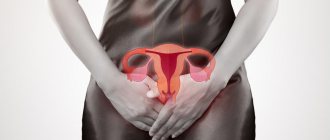Uterine prolapse (prolapse) means abnormal position of the uterus and its displacement below the normal border. This occurs because the muscles and ligaments of the pelvis weaken and cannot hold the organs in the correct position. In most cases, the vagina descends along with the uterus.
Downward movement of the uterus also often leads to displacement of the rectum and bladder, which leads to disruption of the functioning of these organs: constipation, colitis, incontinence of urine, feces, gases and other equally serious problems.
Stages of uterine prolapse and prolapse
Uterine prolapse develops gradually, moving from slight displacement to complete prolapse.
The disease occurs in four stages:
- the cervix is located above the entrance to the vagina, but the uterus is not visible from the outside;
- any straining, including sneezing, coughing and lifting heavy objects, causes the cervix to briefly protrude into the genital opening;
- incomplete uterine prolapse regardless of straining;
- complete prolapse of the uterus with the inability to set it back.
Uterine prolapse - symptoms and treatment
Making a decision on patient management tactics depends on a number of reasons:
- the severity of uterine prolapse or prolapse;
- diseases of adjacent organs (hydrocele, rectocele);
- age;
- the need to preserve menstrual and reproductive functions.
Methods for treating uterine prolapse can be both conservative and surgical, but preference is given to surgical correction.
Conservative treatment
If there are no dysfunctions of neighboring organs, therapy includes therapeutic exercises to strengthen the pelvic muscles (Kegel, Yunusov exercises).
Additionally, a complex of physiotherapeutic procedures, gynecological massage,[25] the use of pessaries,[26] which are elastic rubber rings containing air, are carried out. Thanks to this, the vaginal fornix and cervix are fixed.
Surgery
Surgical treatment is currently the most effective treatment method for patients with uterine prolapse or prolapse. Modern capabilities make it possible to perform a number of operations with a significant degree of uterine prolapse; for convenience, they can be divided according to the anatomical component involved in strengthening and correcting the position of the organs.
Strengthening the pelvic floor, bladder, muscles and fascia of the vagina is referred to as vaginoplasty. Colpoperineolevatoplasty - an operation consisting of strengthening the pelvic floor muscles, can be either an independent operation or an additional stage of treatment. It is more often performed on patients of the older age group, for whom reproductive issues are not relevant.[27]
Surgeries aimed at shortening and strengthening the round ligaments of the uterus do not give such reliable results and the disease often recurs, since the ligaments tend to stretch. Surgeries using alloplastic[28] and synthetic materials are widely used in practice.[29][30] The disadvantages of these methods are a high number of relapses, rejection of allografts, fistulas, and inflammatory reactions.[28] Surgeries used for uterine prolapse are usually performed using abdominal laparoscopic access through the anterior abdominal wall,[31] as well as vaginal access.
Hysterectomy is the complete removal of the uterus, performed on older patients when there is no need to preserve reproductive function. At the moment it is the only radical treatment method.
Today, there are three main trends in modern surgery for uterine prolapse:
1. Widespread use of mesh implants;
2. Reducing invasiveness - using thread lifting;
3. The use of fillers - injection techniques for correcting changes in the perineum and vagina.
The use of mesh implants can reduce the likelihood of relapses of uterine and vaginal prolapse. In this case, the vaginal walls are strengthened with a very elastic, but at the same time durable prolene mesh. A few months after the operation, this mesh grows with its own connective tissue elements and blood vessels. As a result of this, a new, very strong ligamentous apparatus is formed.
Using the thread lifting technique allows you to restore the normal width of the vagina after childbirth or gynecological operations with minimal trauma.
Contour intimate plastic surgery involves the injection of special substances that allow you to correct imperfections in the genital area without surgery. Widely used in aesthetic gynecology.
After surgical treatment, it is recommended to carry out conservative measures, therapeutic exercises and massage.
Treatment at home
When the first symptoms of uterine prolapse appear, you should consult a gynecologist. Self-medication is unacceptable and can lead to serious complications, such as complete uterine prolapse.
Rehabilitation
After the operation, for two months you should:
- maintain sexual rest;
- use pads instead of vaginal tampons;
- sit reclining, transferring weight to the tailbone, while the muscles are relaxed.
Who experiences uterine prolapse and prolapse?
Most of us associate uterine prolapse with old age, when the functioning of all organs deteriorates. But in fact, displacement of the internal genital organs occurs even in young and nulliparous girls.
According to statistics, prolapse and prolapse of the uterus occurs in almost 10% of women under thirty years of age. At the age of forty, this disease is observed in 35-40% of women, and after fifty years, more than half of women know firsthand what uterine prolapse is and the problems associated with it.
Tampons for uterine prolapse
Uterine prolapse is an unpleasant disease characterized by displacement of the fundus and cervix below the anatomical border. The disease develops as a result of birth trauma to the pelvic muscles or ruptures of the perineum.
Due to this condition, the abdominal muscles cease to function properly, so not only the reproductive organ is displaced, but also the intestines, appendages and other internal genital organs are displaced downward. Therefore, lymphatic drainage and blood circulation in the pelvic organs are disrupted. In this case, complex treatment, various tablets and injections are prescribed. But is it possible to use tampons during uterine prolapse: therapeutic and hygienic during menstruation?
Tampons can be therapeutic or hygienic, which are used during critical days. Both of them can be used for this disease.
It is strictly forbidden to use tampons for uterine prolapse at home to eliminate daily vaginal discharge. Otherwise, it will disrupt the vaginal microflora or cause serious injury to the walls of the vaginal canal. They are used only during menstruation or to treat a condition.
When the uterus prolapses during menstruation, tampons can be worn for no more than 6 hours, it is advisable to replace them with another after 3 hours. You cannot put something back that has already been used, even if you took it out immediately after putting it in. This way you can get an infection.
When the uterus prolapses, they can be used, but it is advisable to alternate them with pads and not use them at night. Even during critical days, you cannot use them around the clock.
Contraindications
It is strictly contraindicated to use such tampons if prolapse of the reproductive organ is accompanied by an inflammatory process or an infectious disease.
In this case, they can only be used to eliminate the pathological process. For example, a tampon is moistened in an anti-inflammatory solution of chamomile or boron uterus and inserted into the vagina for several hours. Thus, they can be used for infection and inflammation.
You should also not insert tampons for physiological reasons. If a woman with uterine prolapse has an intravaginal pessary or support rings, the use of such a hygienic product is contraindicated. Inserting a tampon may cause them to dislodge.
Causes of uterine prolapse
Among the main reasons that can lead to prolapse and prolapse of the uterus:
- congenital malformations of the pelvic region;
- birth injuries, difficult births, perineal ruptures, multiple births;
- history of genital surgery;
- heavy physical labor, frequent lifting of weights, including overly active fitness activities;
- estrogen deficiency;
- increased pressure in the abdominal cavity;
- atrophic changes, weakening of the muscles and ligaments of the pelvic floor;
- chronic constipation;
- frequent strained cough;
- obesity;
- neoplasms developing in the abdominal cavity.
When to see a doctor
Prolapse and prolapse of the uterus in the initial stages is manifested by the following symptoms:
- nagging pain in the lower abdomen and lower back, which intensifies towards the end of the day;
- sensation of a foreign body in the vagina;
- pain during sexual intercourse;
- whitish or bloody vaginal discharge outside the menstrual cycle;
- menstrual irregularities.
If a woman ignores the first warning signs of prolapse and does not contact a gynecologist, the disease will progress, and in the future she may independently detect prolapse of the uterus protruding from the genital slit. Complete prolapse of the uterine body leads to constant discomfort and severe pain.
Without treatment, uterine prolapse causes the development of cystitis, pyelonephritis, and kidney stones. A woman begins to suffer from frequent, or, conversely, difficult urination, involuntary leakage of urine and urinary incontinence, when it becomes difficult to run to the toilet in time when the urge arises. All this entails the appearance of an unpleasant odor, which is not so easy to get rid of.
If the rectum is displaced, problems with bowel movements, severe constipation and hemorrhoids may occur.
In many cases, complex treatment of uterine prolapse and prolapse is carried out with the involvement of not only a gynecologist, but also a urologist and a proctologist.
Treatment of uterine prolapse at home
As for traditional medicine for uterine prolapse, there are a large number of herbal collections both for oral administration and for baths and douching. However, a good result can only be achieved with the combined use of herbal medicine and traditional methods, primarily therapeutic exercises.
Potentilla erecta tincture
To improve the muscle tone of the pelvic organs, prepare a tincture: 50 g of crushed Potentilla erecta root, pour 0.5 liters of vodka. Leave in a dark place at room temperature for 3 weeks.
After straining, take 30 drops, diluted in a small amount of water, 3 times a day before meals for 1 month. After taking a week break, repeat the course.
Sitz baths with yarrow and St. John's wort
To eliminate such unpleasant symptoms as heaviness, burning, tingling, inflammation in the pelvic area, use the following recipes. One glass of crushed St. John's wort and yarrow, taken in equal parts, pour 2 liters of water, boil over low heat for 15 minutes, leave for 1 hour.
After straining, cool to 37-37.5 degrees and use for a sitz bath. Reception time: 15-20 minutes. Do the procedure every other day at night for a month, courses can be repeated at intervals of 2 weeks.
Baths with dandelion leaves
Prolapse of the uterus is treated at home with dandelion. Pour 100 g of crushed dandelion leaves into 5 liters of boiling water, keep on low heat for 2-3 minutes, leave covered for 1 hour. After straining, add the broth to a warm bath. Reception time - 20 minutes
Douching with castor bean decoction
30 g of castor bean herb, pour 0.5 liters of boiling water, keep on low heat for 15 minutes, leave for 1 hour. After straining, cool to 36.5-37 degrees and use a syringe to do vaginal rinsing: once a day at night for 2 weeks.
The danger of self-medication for prolapse and uterine prolapse
Performing any physical exercises, popular Kegel exercises, taking medications, tinctures and decoctions of medicinal herbs must be agreed upon with a gynecologist. What helped your friend or the heroine of an article you read somewhere with prolapse of the uterus may not help you, or may worsen the situation. Remember: advanced uterine prolapse can only be treated surgically.
Self-medication of uterine prolapse can lead to disruption of internal organs, uterine injuries, the formation of deep bleeding ulcers and constant discomfort. With such problems, it is difficult, and sometimes impossible, to lead a normal sex life and feel like a happy woman and mother.
Gymnastics to lift the pelvic floor muscles
Very good reviews can be found from women who have cured uterine prolapse at home by performing special gymnastics.
Gymnastics for prolapsed uterine walls is simple. Exercises related to raising the legs help the uterus find its place. Make sure that it is not the abdominal muscles that are working, but the vaginal muscles.
- Slowly lower and raise your legs.
- Make “scissors” and “birch”.
- Do the bicycle exercise.
- Place your feet on the floor. Close your knees and squeeze them with great force. You should feel the tension in your thighs. Hold the position for 10 seconds and relax.
- Exercises involving pinching a ball above the knees, as close to the vagina as possible, have also proven effective. You need to take a small ball - up to 15 cm in diameter. You need to hold it and walk in a circle for 2 minutes in small steps.
- You can walk with the ball clamped, alternately straining and contracting the vaginal muscles.
Gymnastics during uterine prolapse should be regular and intense, then the result will please you.










